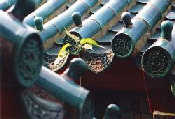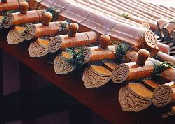|
China's Spectacular Roofs
Roofs are very important to Chinese architecture: Not only do they protect
residences from the elements, but they also have a deeper meaning. For example,
temple roofs are curved because Buddhists believed that this helped ward off
evil spirits, which were believed to assume the form of straight lines. Temple
roofs were also made of glazed ceramic tiles and have an overhanging cave
distinguished by a graceful upward slope. The roof arch comes from the
intricately fitted rafters, which were jointed together.
Wealthy homes and palaces had particularly elaborate roofs. One perfect
example is the Forbidden City, and the 13 Ming tombs outside of Beijing have
roof tiles of brilliant yellow, green and red hues. The ridges of each roof are
topped with figures of mythical creatures, each curve no more than a sweep, and
the most intricate designs almost always pointing southeast. However, there are
some obstacles to having such decorations on the roof: The tremendous weight can
eventually bring down the entire complex. This is why the Chinese have added an
additional column to support the weight under the outer edges, reducing the
bracket system to a mere decoration. The brackets are decorated by elaborate
paintings with bright colors and eye-catching designs.
  The distinctive roof of Chinese architecture involves a
great deal of symbolism. Symbolism is present in the colors of the eaves,
roofing materials and roof top decorations. A roof usually has wave-like tiles
that run horizontally, and vertical round ridges that run vertically. The
vertical ridges are symbolic of bamboo, which represents youth and longevity.
Since gold/yellow is an auspicious (good) color, imperial roofs are gold or
yellow. Green roofs symbolize bamboo shafts, which, in turn, represent youth and
longevity. The distinctive roof of Chinese architecture involves a
great deal of symbolism. Symbolism is present in the colors of the eaves,
roofing materials and roof top decorations. A roof usually has wave-like tiles
that run horizontally, and vertical round ridges that run vertically. The
vertical ridges are symbolic of bamboo, which represents youth and longevity.
Since gold/yellow is an auspicious (good) color, imperial roofs are gold or
yellow. Green roofs symbolize bamboo shafts, which, in turn, represent youth and
longevity.
|
|


